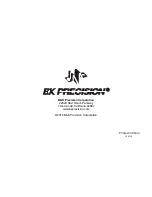
10
OPERATING INSTRUCTIONS
5 VDC Output
The 5 Vdc is a fixed voltage supply providing up to 500 mA (0.5 amp)
continuous. The 5 Vdc output is available at the two right
OUTPUT 5V
tie
points. Be sure to observe polarity.
1.
The 12V and 5V supplies will provide up to 1 amp
for a short period, but thermal shutdown may occur
when the output is overloaded for a few minutes.
Upon thermal shutdown there will be now output. If
thermal shutdown occurs, remove the load and wait
15 minutes for the power supply to cool. Normal
operation may then resume.
2.
Overloading May also cause sever ripple I the output
which could disrupt operation of the circuit being
powered. Excessive ripple will produce a loud hum
in devices with speakers.
3.
You can prevent overloading by measuring the
output current with an external multimeter. Set the
meter to measure current (a 2 amp range is desirable,
or a 10 amp range may be used) and connect is
"series" with the load. Load current up to 500 mA
may be operated continuously, load current greater
than 500 mA must be short term, maximum short
term current is 1 amp.
DUAL OR TRIPLE OUTPUT
Two of the outputs, or all three of the outputs may be used
simultaneously if desired. The three outputs are fully isolated from ground,
and each other, thus each output may be connected for the either positive
or negative polarity.
A typical example of a triple output application would be powering a
circuit board that requires three voltages, such as +5, +12V and -12V. Fig.
4 shows how the outputs would be connected for this example, and the
following procedures reviews the steps of hook-up.
1.
The variable supply would be set for 12V. WE will assign the
variable supply as the +12V source and the fixed 12V supply as
the -12V source.
2.
Connect the - terminal of the 5V supply to circuit board common
and the + terminal to the +5V input of the board.
3.
Connect the - terminal of the variable supply to circuit board
common (or the terminal of the 5V supply). Connect the +
terminal of the variable supply to the +12V input of the board.
4.
Connect the + terminal of the fixed 12V supply to circuit board
common (or the - terminal of the 5V and variable supplies).
Connect the - terminal of the fixed 12V supply to the -12V input
of the board.
CONNECTING OUTPUTS IN SERIES
When the 30 volt output of the variable supply is not adequate, the
outputs may be connected in series to provide a variable 17 to 47 volt
output. Since the supplies are connected in series, the maximum current is
the same as for the fixed voltage supplies, that, 500 mA continuous or 1
amp peak. Connections for the configuration are shown in Fig. 5.
CAUTION








































